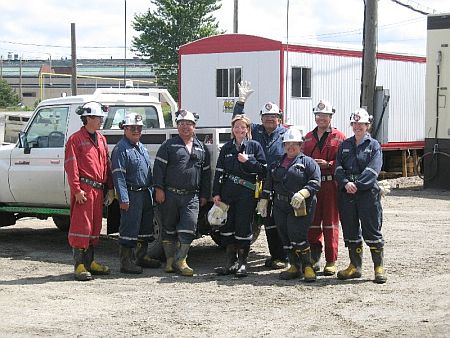 The journey is just as important as the outcome.
The journey is just as important as the outcome.
For Vale Inco and the Sagamok Anishnawbe community, this journey is about building relationships.
"We see the process of communicating on an ongoing basis as being just as important as the outcomes," said Jackie Lamothe, Vale Inco's manager of Aboriginal affairs.
"We're looking at the long term. When you build a relationship with a community, over time you will develop an understanding of each other's needs and how to balance operating a business within traditional territories and preserving what is important to that community."
Vale Inco is negotiating an Impact Benefit Agreement with the Sagamok Anishnawbe as the company's Totten Mine is located on the band's traditional lands in Worthington, 35 kilometres west of Sudbury. The project dates back to 1966 when two shafts were sunk but left idle in 1972 due to low metal prices.
In 2005, rising metal prices prompted the company to re-evaluate the mine's potential nickel, copper and precious metal deposits. A feasibility study was conducted and a decision was made to invest $450 million to bring the mine into production. Construction began in 2006 with the goal to start production in 2011, creating 150 new jobs.
The closure plan submitted by Vale Inco triggered the "duty to consult and accommodate" in accordance with the 2006 Supreme Court ruling.
Lamothe said Vale Inco approached the community at that time and began the process of working together. An interim memorandum of understanding was signed as a prelude to negotiating an Impact Benefit Agreement.
"It involves a lot of resources when you're in negotiation with a company," said Dean Assinewe, Sagamok's mineral liaison co-ordinator. "There are meetings and dialogue going back and fourth.
The bottom line is that you are building a relationship. ... We've been at it for a few years and we're getting more familiar with the people around the table and the (mining) business."
Consistency, flexibility
As both parties continue the journey, Lamothe has learned that consistency and flexibility are important tools toward establishing trust."We need to be flexible," she said. "Sometimes, it is easy to get stuck on policies and practices that have been in place for years. We found we can still maintain our standards while being creative and flexible about how we practice some of the processes we have in place."
Consistency at the table with key points of contact from both the community and company helps with continuity and propelling the negotiations forward.
Assinewe said Vale Inco's restructuring, changes at the executive level and the strike have slowed the momentum somewhat.
First Nations become decision makers when companies are required to apply for permits, particularly for environmental requests like taking water, building roads, moving lakes or constructing tailings ponds, he said.
"That is where the need for consultation becomes a front-line matter in which the communities are involved."
For the Anishnawbe people, the relationship to the land is the highest priority, said Assinewe.
"We've seen the effects of industry and we've experienced contamination in rivers," he said. "We're not going to put industry above the land and what it provides to us and our traditions. Our hunting, fishing, language and way of life are all tied into that relationship to the land. Industry needs to understand that and I think we're successful at relaying that to them."
Vale Inco's situation is unique in that it has been operating mines and processing plants in the Sudbury region for more than 100 years, but is only now developing formal relationships with First Nation communities.
100-year wall
"One of our objectives is to go in early and be completely honest and forthcoming with the community about what happens during the mining cycle," Lamothe said, emphasizing that education is key. It's also important to set realistic expectations with communities in order to remain sustainable throughout the boom and bust cycle.
The Sagamok Anishnawbek calls the previous lack of involvement the "100-year wall," but changing laws and hiring practices have sharpened Aboriginal interest in skills training and job opportunities. Assinewe liaises with industry, government and the community, keeping abreast of the job market and natural resource developments in mining, forestry and energy.
"I'll be in contact not only with the major companies, but also with their contractors," he said. "We're trying to forge relationships with them to take advantage of some of the contracting opportunities at Totten."
Employment
One of Vale Inco's objectives is to increase Aboriginal participation in its workforce. The company does recognize cultural differences, the need to implement various outreach programs, and to work directly with the people in the community in order to educate members on what training is required or how to access it.Lamothe said the company will also focus on retention once the hiring freeze is lifted. Aboriginals are the only population group showing positive growth, so the company sees First Nation communities as a pool of available candidates for employment.
One strategy both community and company are working toward is capacity building aimed at the youth. Assinewe said the community is designing a Junior Achievement program to enhance the learning experience for Sagamok youth.
The company has also extended its corporate hand by offering mine tours and participation in career fairs and community events.
Vale Inco is also initiating a relationship with the Whitefish Lake First Nation, now called Atikameksheng Anishnawbek, 19 kilometres west of Sudbury.
Best practices
- Flexibility
- Consistency
- Transparency
- Make presentations to the community and communicate what is discussed at the table
- Present a holistic view of what a mine represents

